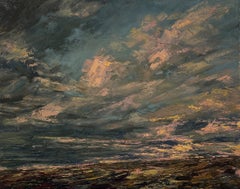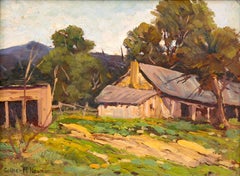Joseph Rodefer DeCamp Art
American, 1858-1923
Born in Cincinnati, Ohio in 1858, Joseph DeCamp began his artistic career in his teens and remained active throughout his life. Although he initially painted landscapes, Decamp became a renowned and respected portraitist. He was famous for his images of men of high society and women within domestic interiors.
Decamp began his artistic training in 1873 when he enrolled in the McMicken School of Art and Design in Cincinnati. DeCamp studied under Thomas Satterwhite Noble for five years, but was also a student of Frank Duveneck at the Ohio Mechanics Institute. He adopted Duveneck's bold, realistic style and many of his paintings executed throughout the 1870s and 1880s reflect this influence.
Like most American artists of his generation, DeCamp went abroad to study. In 1878, following in the footsteps of Duveneck and other Midwesterners, he traveled to Munich to attend the Royal Bavarian Academy. Soon after his arrival, however, he gravitated away from the academy and towards Duveneck and eventually followed his mentor to Florence and Venice. During these years, DeCamp focused on landscape and portraiture as his primary subjects. These themes would continue to occupy the artist when he returned to America in 1883.
When DeCamp arrived back in the United States in 1883, he first settled in Cincinnati, but soon moved to Cleveland to teach at what is now Case Western. He then relocated once more to the Boston area, where he would remain for most of his life. He quickly established himself as one of the leading figures in the Boston art community and became a founding member of The Ten American Painters, formulated in 1897. This group included Childe Hassam, John Henry Twachtman, Julian Alden Weir, Frank Benson, Thomas Dewing, Willard Metcalf, Robert Reid, Edward Simmons, Edmund Tarbell, and William Merritt Chase. These artists were dedicated to experimentation with various styles, particularly impressionism. They also wanted more opportunity for exhibitions outside the established venues. Many, including DeCamp, had joined the Society of American Artists (SAA) when this group broke from the conservative National Academy of Design in 1877. However, The Ten American Painters felt that the SAA had itself become too restrictive. Banding together, The Ten exhibited their works as a group between 1898 and 1919. Unfortunately, many of his works were destroyed in fires at both his Boston and Maine studios.
Like most painters of his time, DeCamp usually left the bustle of the urban environment during the summer months and sketched and painted outdoors. According to DeCamp biographer Laurene Buckley, the artist "returned to landscape as a subject, especially in 1886, after he had spent the first of many summers at Annisquam on the Massachusetts coast, near Gloucester." Painters such as Hugh Bolton Jones, William Lamb Picknell, and others who had worked at the Pont-Aven art colony in Brittany frequented the thriving art community that developed in Annisquam. Many of these artists, including DeCamp, worked en plein air. to
1
1
Overall Width
to
Overall Height
to
1
1
1
1
1
1
1
8,917
2,810
2,504
1,337
1
1
Artist: Joseph Rodefer DeCamp
"Summer Landscape, " Joseph DeCamp, Boston Ten American Impressionists
By Joseph Rodefer DeCamp
Located in New York, NY
Joseph Rodefer DeCamp (1858 - 1923)
Summer Landscape
Oil on board
11 x 15 inches
Signed lower right
Born in Cincinnati, Ohio on November 5, 1858, Joseph DeCamp began his artistic career in his teens and remained active throughout his life. Although he initially painted landscapes, Decamp became a renowned and respected portraitist. He was famous for his images of men of high society and women within domestic interiors.
Decamp began his artistic training in 1873 when he enrolled in the McMicken School of Art and Design in Cincinnati. The head of the school, Thomas Satterwhite Noble, was a European-trained painter whose "insistence on rigorous draftsmanship, true to the academic manner in which he had been trained, exerted a lasting influence on DeCamp." DeCamp studied under Noble for five years, but was also a student of Frank Duveneck at the Ohio Mechanics Institute. He adopted Duveneck's bold, realistic style and many of his paintings executed throughout the 1870s and 1880s reflect this influence.
Like most American artists of his generation, DeCamp went abroad to study. In 1878, following in the footsteps of Duveneck and other Midwesterners, he traveled to Munich to attend the Royal Bavarian Academy. Soon after his arrival, however, he gravitated away from the academy and towards Duveneck and eventually followed his mentor to Florence and Venice. During these years, DeCamp focused on landscape and portraiture as his primary subjects. These themes would continue to occupy the artist when he returned to America in 1883.
When DeCamp arrived back in the United States in 1883, he first settled in Cincinnati, but soon moved to Cleveland to teach at what is now Case Western Reserve University. He then relocated once more to the Boston area, where he would remain for most of his life. DeCamp began teaching at Wellesley Female Academy and, in the fall of 1885, began as an instructor at the School of Drawing and Painting at the Museum of Fine Arts in Boston. He quickly established himself as one of the leading figures in the Boston art community and became a founding member of The Ten American Painters, formulated in 1897. This group included Childe Hassam, John Henry Twachtman, Julian Alden Weir, Frank Benson, Thomas Dewing, Willard Metcalf, Robert Reid, Edward Simmons...
Category
19th Century American Impressionist Joseph Rodefer DeCamp Art
Materials
Oil, Panel
$16,000 Sale Price
20% Off
Related Items
"Eastern Plains of Colorado" By Sparky LeBold, Colorado Landscape Oil Painting
Located in Denver, CO
"Eastern Plains of Colorado" by Sparky LeBold (US and Portugal based) is a beautiful handmade oil painting that depicts a view of the vast green plains of Colorado, with the famed su...
Category
2010s American Impressionist Joseph Rodefer DeCamp Art
Materials
Oil, Panel
Old House, Built in 1848
By Gilbert Neumann
Located in Austin, TX
"Old House, Built in 1848" by painter Gilbert F. Neumann
Medium: Oil paint on panel
Size: 9 x 12 inches
Frame Size: 14 x 18.5 inches
A nostalgic painting of ...
Category
20th Century American Impressionist Joseph Rodefer DeCamp Art
Materials
Oil, Panel
"Evening View to the South West" , Oil Painting
By David Grossmann
Located in Denver, CO
David Grossman's (US based) "Evening View to the South West" is an original, handmade oil painting that depicts a wide open plain of the West with fields of...
Category
2010s American Impressionist Joseph Rodefer DeCamp Art
Materials
Linen, Oil, Panel
"Mt. Evans and Bierstadt, Colorado" (2016) By David Shingler, Oil Landscape
Located in Denver, CO
David Shingler’s "Mt. Evans and Bierstadt, Colorado" (2016) is an original oil painting on wood panel, measuring 16 x 20 inches (40.64 x 50.80 cm). Known for his dynamic landscapes r...
Category
2010s American Impressionist Joseph Rodefer DeCamp Art
Materials
Oil, Wood Panel
"Composition #59" Oil Painting
Located in Denver, CO
Jeremy Mann's "Composition #59" is an original, handmade oil painting that depicts a dark city setting filled with fog and passerby.
About the artist:
Je...
Category
Early 2000s American Impressionist Joseph Rodefer DeCamp Art
Materials
Oil, Panel
Jardin des Tuileries - Impressionist Landscape Oil by William Samuel Horton
By William Samuel Horton
Located in Marlow, Buckinghamshire
Signed and dated oil on panel landscape by American impressionist painter William Samuel Horton. The piece depicts a view of the Tuileries Garden in Paris, France. It's a winter scen...
Category
Early 1900s American Impressionist Joseph Rodefer DeCamp Art
Materials
Panel, Oil
"After Sunset" (2023) By Linda Lillegraven, Original Oil Painting on Linen
By Linda Lillegraven
Located in Denver, CO
Linda Lillegraven's beautiful original oil landscape "After Sunset" (2023) depicts a serene moment of a western plain at evening, with a herd of cows far in the distance.
Linda Lill...
Category
2010s American Impressionist Joseph Rodefer DeCamp Art
Materials
Linen, Oil, Panel
Crosby’s Boat Yard, Cape Cod
Located in Spokane, WA
Titled on verso panel
Signed lower left corner
Measures
Painting 17 x 22 inches
Framed 21.125 x 26.75 inches
William H. Kinnicutt (1865–1934) was an American artist known for his ...
Category
Early 20th Century American Impressionist Joseph Rodefer DeCamp Art
Materials
Oil, Panel
"Denver - Under the 8th St Bridge" (2019) By Christopher Clark, Oil painting
By Christopher Clark
Located in Denver, CO
Christopher Clark’s oil on panel painting “Denver - Under the 8th Street Bridge” depicts the splendor of contrast one immerses themself in throug...
Category
2010s American Impressionist Joseph Rodefer DeCamp Art
Materials
Oil, Wood Panel
$1,200 Sale Price
20% Off
H 20 in W 30 in
"Serenade in the Groves" (2024), Original Oil Painting by Derek Penix
By Derek Penix
Located in Denver, CO
Derek Penix's (US based) "Under the Canopy" is an oil painting that depicts several developed sycamores with a blue sky in the background.
Bio/Artist Statement:
Derek Penix was bo...
Category
2010s American Impressionist Joseph Rodefer DeCamp Art
Materials
Oil, Panel
$4,900
H 29.5 in W 29.5 in
Cradle of Civilization
By Christopher Clark
Located in Denver, CO
Lone figure with city
Category
2010s American Impressionist Joseph Rodefer DeCamp Art
Materials
Oil, Wood Panel
"Country Road" Oil Painting
Located in Denver, CO
Clyde Steadman's "Country Road" is an original, handmade oil painting that depicts an impasto painting of a pastoral setting.
Category
2010s American Impressionist Joseph Rodefer DeCamp Art
Materials
Oil, Panel
Joseph Rodefer Decamp art for sale on 1stDibs.
Find a wide variety of authentic Joseph Rodefer DeCamp art available for sale on 1stDibs. You can also browse by medium to find art by Joseph Rodefer DeCamp in oil paint, paint, panel and more. Much of the original work by this artist or collective was created during the 19th century and is mostly associated with the Impressionist style. Not every interior allows for large Joseph Rodefer DeCamp art, so small editions measuring 23 inches across are available. Customers who are interested in this artist might also find the work of Edward Henry Potthast, Donald Teague, and Paul Bernard King. Joseph Rodefer DeCamp art prices can differ depending upon medium, time period and other attributes. On 1stDibs, the price for these items starts at $16,000 and tops out at $16,000, while the average work can sell for $16,000.

